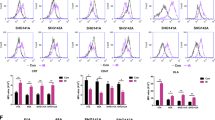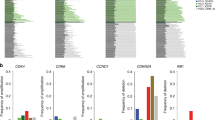Abstract
Effective presentation of tumor antigens by dendritic cells (DCs) is considered to be essential for the induction of antitumor T-cell responses. Apoptotic and necrotic tumors have been noted to be a robust antigen source for DCs. Because glioma cells undergo apoptosis after transfection with the type I interferon (IFN) gene and type I IFNs promote the stimulatory activity of DCs, we hypothesized that transfection of glioma cells with type I IFN genes and provision of DCs would promote particularly effective antitumor activity by both facilitating apoptosis of glioma cells and the presentation of the glioma antigens, thereby inducing specific immune responses against glioma cells. We have previously reported the proof of this hypothesis in vitro and in a subcutaneous tumor model. Here we report an extension of this approach in intracranial (i.c.) gliomas using adenoviral IFN-α (Ad-IFN-α) vector. Mice bearing day-5 i.c. GL261 glioma received sequential intratumoral (i.t.) delivery of Ad-IFN-α and bone marrow-derived syngeneic DCs. This treatment prolonged survival in that nine of 17 animals survived long term (>60 days versus 0 of 10 control animals). Specific CTL activity was demonstrated following this regimen in the cervical lymph nodes, and the therapeutic efficacy was dependent upon CD8+ cells. Furthermore, these animals were protected against subsequent re-challenge with GL261 gliomas. DCs injected i.t. survived in the tumor and migrated into cervical lymph node. In vitro migration assays revealed the ability of DCs to migrate toward the tumor, suggesting that i.t. injected DCs migrate through the glioma. Taken together, this combination of gene therapy and cellular immunotherapy may be an effective future strategy for treating human gliomas.
This is a preview of subscription content, access via your institution
Access options
Subscribe to this journal
Receive 12 print issues and online access
$259.00 per year
only $21.58 per issue
Buy this article
- Purchase on Springer Link
- Instant access to full article PDF
Prices may be subject to local taxes which are calculated during checkout





Similar content being viewed by others
References
Suter T et al. The brain as an immune privileged site: dendritic cells of the central nervous system inhibit T cell activation. Eur J Immunol 2003; 33: 2998–3006.
Badie B, Bartley B, Schartner J . Differential expression of MHC class II and B7 costimulatory molecules by microglia in rodent gliomas. J Neuroimmunol 2002; 133: 39–45.
Lefevre F et al. Interferon-delta: the first member of a novel type I interferon family. Biochimie 1998; 80: 779–788.
Nardelli B et al. Regulatory effect of IFN-kappa, a novel type I IFN, on cytokine production by cells of the innate immune system. J Immunol 2002; 169: 4822–4830.
Honda K et al. Selective contribution of IFN-alpha/beta signaling to the maturation of dendritic cells induced by double-stranded RNA or viral infection. Proc Natl Acad Sci USA 2003; 100: 10872–10877.
Della Bella S et al. Functional repertoire of dendritic cells generated in granulocyte macrophage-colony stimulating factor and interferon-α. J Leukoc Biol 2004; 75: 106–116.
Montoya M et al. Type I interferons produced by dendritic cells promote their phenotypic and functional activation. Blood 2002; 99: 3263–3271.
Le Bon A et al. Cross-priming of CD8+ T cells stimulated by virus-induced type I interferon. Nat Immunol 2003; 4: 1009–1015.
Cho HJ et al. IFN-alpha beta promote priming of antigen-specific CD8+ and CD4+ T lymphocytes by immunostimulatory DNA-based vaccines. J Immunol 2002; 168: 4907–4913.
Chawla-Sarkar M, Leaman DW, Borden EC . Preferential induction of apoptosis by interferon (IFN)-beta compared with IFN-alpha2: correlation with TRAIL/Apo2L induction in melanoma cell lines. Clin Cancer Res 2001; 7: 1821–1831.
Nakahara N et al. Effective induction of antiglioma cytotoxic T cells by coadministration of interferon-beta gene vector and dendritic cells. Cancer Gene Ther 2003; 10: 549–558.
Matarrese P et al. Type I interferon gene transfer sensitizes melanoma cells to apoptosis via a target activity on mitochondrial function. Am J Pathol 2002; 160: 1507–1520.
Thyrell L et al. Mechanisms of interferon-alpha induced apoptosis in malignant cells. Oncogene 2002; 21: 1251–1262.
Santini SM et al. Type I interferon as a powerful adjuvant for monocyte-derived dendritic cell development and activity in vitro and in Hu-PBL-SCID mice. J Exp Med 2000; 191: 1777–1788.
Liu S et al. The involvement of TNF-alpha-related apoptosis-inducing ligand in the enhanced cytotoxicity of IFN-beta-stimulated human dendritic cells to tumor cells. J Immunol 2001; 166: 5407–5415.
Hiroishi K, Tuting T, Lotze MT . IFN-alpha-expressing tumor cells enhance generation and promote survival of tumor-specific CTLs. J Immunol 2000; 164: 567–572.
Buckner JC et al. A phase III study of radiation therapy plus carmustine with or without recombinant interferon-alpha in the treatment of patients with newly diagnosed high-grade glioma. Cancer 2001; 92: 420–433.
Wakabayashi T et al. Initial and maintenance combination treatment with interferon-beta, MCNU (Ranimustine), and radiotherapy for patients with previously untreated malignant glioma. J Neurooncol 2000; 49: 57–62.
Natsume A, Mizuno M, Ryuke Y, Yoshida J . Antitumor effect and cellular immunity activation by murine interferon-beta gene transfer against intracerebral glioma in mouse. Gene Therapy 1999; 6: 1626–1633.
Yoshida J, Mizuno M, Nakahara N, Colosi P . Antitumor effect of an experimental human glioma by adeno-associated virus vector containing the human interferon-beta gene. Jpn J Cancer Res 2002; 93: 223–228.
Gallucci S, Lolkema M, Matzinger P . Natural adjuvants: endogenous activators of dendritic cells. Nat Med 1999; 5: 1249–1255.
Albert ML, Sauter B, Bhardwaj N . Dendritic cells acquire antigen from apoptotic cells and induce class I-restricted CTLs. Nature 1998; 392: 86–89.
Albert ML et al. Immature dendritic cells phagocytose apoptotic cells via alphavbeta5 and CD36, and cross-present antigens to cytotoxic T lymphocytes. J Exp Med 1998; 188: 1359–1368.
Inaba K et al. Efficient presentation of phagocytosed cellular fragments on the major histocompatibility complex class II products of dendritic cells. J Exp Med 1998; 188: 2163–2173.
Vermes I, Haanen C, Steffens-Nakken H, Reutelingsperger C . A novel assay for apoptosis. Flow cytometric detection of phosphatidylserine expression on early apoptotic cells using fluorescein labelled Annexin V. J Immunol Methods 1995; 184: 39–51.
Ehtesham M et al. Intratumoral dendritic cell vaccination elicits potent tumoricidal immunity against malignant glioma in rats. J Immunother 2003; 26: 107–116.
Benedetti S et al. Gene therapy of experimental brain tumors using neural progenitor cells. Nat Med 2000; 6: 447–450.
Okada H et al. Cytokine gene therapy of gliomas: effective induction of therapeutic immunity to intracranial tumors by peripheral immunization with interleukin-4 transduced glioma cells. Gene Therapy 2001; 8: 1157–1166.
Walker PR, Calzascia T, De Tribolet N, Dietrich PY . T-cell immune responses in the brain and their relevance for cerebral malignancies. Brain Res Brain Res Rev 2003; 42: 97–122.
Lampson LA . Beyond inflammation: site-directed immunotherapy. [Review] [32 refs]. Immunol Today 1998; 19: 17–22.
Fischer HG, Reichmann G . Brain dendritic cells and macrophages/microglia in central nervous system inflammation. J Immunol 2001; 166: 2717–2726.
Carson MJ . Microglia as liaisons between the immune and central nervous systems: functional implications for multiple sclerosis. GLIA 2002; 40: 218–231.
Graeber MB, Scheithauer BW, Kreutzberg GW . Microglia in brain tumors. GLIA 2002; 40: 252–259.
Hishii M et al. Human glioma-derived interleukin-10 inhibits antitumor immune responses in vitro. Neurosurgery 1995; 37: 1160–1166.
Lin CM, Wang FH, Lee PK . Activated human CD4+ T cells induced by dendritic cell stimulation are most sensitive to transforming growth factor-beta: implications for dendritic cell immunization against cancer. Clin Immunol 2002; 102: 96–105.
Saas P et al. CD95 (Fas/Apo-1) as a receptor governing astrocyte apoptotic or inflammatory responses: a key role in brain inflammation? J Immunol 1999; 162: 2326–2333.
Yang T et al. Glioma-associated hyaluronan induces apoptosis in dendritic cells via inducible nitric oxide synthase: implications for the use of dendritic cells for therapy of gliomas. Cancer Res 2002; 62: 2583–2591.
Tatsumi T et al. Intratumoral delivery of dendritic cells engineered to secrete both interleukin (IL)-12 and IL-18 effectively treats local and distant disease in association with broadly reactive Tc1-type immunity. Cancer Res 2003; 63: 6378–6386.
Moschella F et al. Gene expression profiling and functional activity of human dendritic cells induced with IFN-alpha-2b: implications for cancer immunotherapy. Clin Cancer Res 2003; 9: 2022–2031.
Leverkus M et al. Maturation of dendritic cells leads to up-regulation of cellular FLICE-inhibitory protein and concomitant down-regulation of death ligand-mediated apoptosis. Blood 2000; 96: 2628–2631.
Hirao M et al. CC chemokine receptor-7 on dendritic cells is induced after interaction with apoptotic tumor cells: critical role in migration from the tumor site to draining lymph nodes. Cancer Res 2000; 60: 2209–2217.
Weller RO . The immunopathology of brain tumours. In: Blecham NM (ed). Tumours of the Brain. Springer: Heidelberg, Tokyo pp 19–33.
Wiendl H et al. A functional role of HLA-G expression in human gliomas: an alternative strategy of immune escape. J Immunol 2002; 168: 4772–4780.
Wischhusen J et al. Identification of CD70-mediated apoptosis of immune effector cells as a novel immune escape pathway of human glioblastoma. Cancer Res 2002; 62: 2592–2599.
Menetrier-Caux C et al. IL-4 prevents the blockade of dendritic cell differentiation induced by tumor cells. Cancer Res 2001; 61: 3096–3104.
Miyamoto NG et al. Interleukin-1beta induction of the chemokine RANTES promoter in the human astrocytoma line CH235 requires both constitutive and inducible transcription factors. J Neuroimmunol 2000; 105: 78–90.
Barnes DA, Huston M, Perez HD . TNF-alpha and IL-1beta cross-desensitization of astrocytes and astrocytoma cell lines. J Neuroimmunol 1998; 87: 17–26.
Zhou ZH et al. Regulation of monocyte chemoattractant protein (MCP)-1 transcription by interferon-gamma (IFN-gamma) in human astrocytoma cells: postinduction refractory state of the gene, governed by its upstream elements. FASEB J 2001; 15: 383–392.
Sallusto F et al. Rapid and coordinated switch in chemokine receptor expression during dendritic cell maturation. Eur J Immunol 1998; 28: 2760–2769.
Santambrogio L et al. Extracellular antigen processing and presentation by immature dendritic cells. Proc Natl Acad Sci USA 1999; 96: 15056–15061.
Okada H et al. Effective cytokine gene therapy against an intracranial glioma using a retrovirally transduced IL-4 plus HSV-TK tumor vaccine. Gene Therapy 1999; 6: 219–226.
Okada H et al. Gene therapy of malignant gliomas: a pilot study of vaccination with irradiated autologous glioma and dendritic cells admixed with IL-4 transduced fibroblasts to elicit an immune response. Hum Gene Ther 2001; 12: 575–595.
Okada H et al. Bone marrow derived dendritic cells pulsed with a tumor specific peptide elicit effective anti-tumor immunity against intracranial neoplasms. Int J Cancer 1998; 78: 196–201.
Dieu MC et al. Selective recruitment of immature and mature dendritic cells by distinct chemokines expressed in different anatomic sites. J Exp Med 1998; 188: 373–386.
Yanagihara S et al. EBI1/CCR7 is a new member of dendritic cell chemokine receptor that is up-regulated upon maturation. J Immunol 1998; 161: 3096–3102.
Acknowledgements
We thank Drs Marie E Beckner, Manabu Hatano, Michael T Lotze and Paul Robbins (University of Pittsburgh) for their helpful suggestions and discussions. This work was supported by P01 NS40923 (IFP, SCW, HO) and a grant from the Copeland Fund of the Pittsburgh Foundation (HO).
Author information
Authors and Affiliations
Rights and permissions
About this article
Cite this article
Tsugawa, T., Kuwashima, N., Sato, H. et al. Sequential delivery of interferon-α gene and DCs to intracranial gliomas promotes an effective antitumor response. Gene Ther 11, 1551–1558 (2004). https://doi.org/10.1038/sj.gt.3302300
Received:
Accepted:
Published:
Issue Date:
DOI: https://doi.org/10.1038/sj.gt.3302300
Keywords
This article is cited by
-
Genetically engineered mesenchymal stem cells: targeted delivery of immunomodulatory agents for tumor eradication
Cancer Gene Therapy (2020)
-
Mutations of the human interferon alpha-2b gene in brain tumor patients exposed to different environmental conditions
Cancer Gene Therapy (2015)
-
Experimental immunotherapy for malignant glioma: lessons from two decades of research in the GL261 model
Cancer Immunology, Immunotherapy (2011)
-
A Kunjin replicon vector encoding granulocyte macrophage colony-stimulating factor for intra-tumoral gene therapy
Gene Therapy (2009)
-
In vivo bioluminescence imaging in an experimental mouse model for dendritic cell based immunotherapy against malignant glioma
Journal of Neuro-Oncology (2009)



